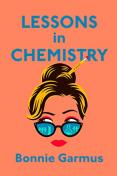BKMT READING GUIDES
Lessons in Chemistry: A Novel
by Bonnie Garmus
Hardcover : 400 pages
901 clubs reading this now
30 members have read this book
Introduction
#1 NEW YORK TIMES BESTSELLER • GMA BOOK CLUB PICK • Meet Elizabeth Zott: “a gifted research chemist, absurdly self-assured and immune to social convention” (The Washington Post) in 1960s California whose career takes a detour when she becomes the unlikely star of a beloved TV cooking show. • STREAM ON APPLE TV
This novel is “irresistible, satisfying and full of fuel” (The New York Times Book Review) and “witty, sometimes hilarious...the Catch-22 of early feminism” (Stephen King, via Twitter).
A BEST BOOK OF THE YEAR: The New York Times, Washington Post, NPR, Oprah Daily, Entertainment Weekly, Newsweek
Chemist Elizabeth Zott is not your average woman. In fact, Elizabeth Zott would be the first to point out that there is no such thing as an average woman. But it’s the early 1960s and her all-male team at Hastings Research Institute takes a very unscientific view of equality. Except for one: Calvin Evans; the lonely, brilliant, Nobel–prize nominated grudge-holder who falls in love with—of all things—her mind. True chemistry results.
But like science, life is unpredictable. Which is why a few years later Elizabeth Zott finds herself not only a single mother, but the reluctant star of America’s most beloved cooking show Supper at Six. Elizabeth’s unusual approach to cooking (“combine one tablespoon acetic acid with a pinch of sodium chloride”) proves revolutionary. But as her following grows, not everyone is happy. Because as it turns out, Elizabeth Zott isn’t just teaching women to cook. She’s daring them to change the status quo.
Laugh-out-loud funny, shrewdly observant, and studded with a dazzling cast of supporting characters, Lessons in Chemistry is as original and vibrant as its protagonist.
Editorial Review
No Editorial Review Currently AvailableDiscussion Questions
FROM THE PUBLISHER:1. The late 1950s into the early 1960s was supposedly a halcyon time in American history. But was it? The war was over and men returned home to take back the jobs women had done in their absence. As a result, women were pushed into more subservient roles. What influences played a part in encouraging women to accept their place as only in the home? And why, in today’s world, when women are in the workforce in record numbers, are they still doing most of the housework and child-raising?
2. Elizabeth Zott had no formal education, and yet she was able to self-educate, thanks to her library card. With the advent of technology, the library almost seems outdated, though many would argue that the library is more important than ever. Do you think libraries are important? If so, why?
3. Why does Elizabeth always wear a pencil in her hair? Is it a weapon or is it a symbol of strength?
4. Elizabeth refuses to accept limits placed on her by society and insists that others also ignore those limits. How do each of those characters ultimately rise to that challenge? And in what ways have you or others been limited by societal norms?
5. In the book, rowing is a metaphor on how Elizabeth sees a better society: that no one person in the boat is more important than the other. Have you ever participated in anything—work, sports, community efforts—where everyone must “row as one” in order to succeed? What are the hurdles people must overcome in order to reach the point where “it all feels easy”?
6. Six-Thirty is amazed by not only how often humans lie to each other, but how poorly they communicate overall. He struggles to understand the word “smart,” finding its very definition unintelligent. What does “smart” actually mean to you? Have you ever thought about what your pet might be trying to teach you?
7. The dictionary first defines faith as “the complete trust or confidence in someone or something” and “a belief in religious doctrine” second. Madeline draws this same distinction—that faith isn’t based on religion. Knowing this, what role does religion play in the book? What is a Humanist? What does the science of psychology tell us about the human’s desire to believe in something greater than themselves? And why do Elizabeth, Calvin, and Wakely all believe that personal responsibility—faith in one’s self—is more important?
8. The book includes male characters who are sympathetic to Elizabeth’s plight, and yet, with the exception of Calvin and Dr. Mason, have trouble standing up for women or other minorities in the workplace. Why do good-hearted people have trouble speaking up? And what are the consequences of not speaking up?
9. Elizabeth is sometimes depressed by the circumstances in her life. Not coincidentally, her show airs in the “Afternoon Depression Zone.” And yet she’s never a victim. How does she continually pick herself up? What fuels her resilience? And why, after she’s reached stardom, is she more miserable than ever?
10. Harriet Sloane is an inveterate magazine reader. How do magazines and media shape our culture? And what did Harriet mean when she first told Elizabeth to “recommit”? Is there some dream of yours that you wish you would recommit to?
11. Friendship and family are interconnected themes in the book. Can friendships sometimes provide family better than family itself? Walter isn’t Amanda’s biological father, but he loves her fully and is the most present person in her life. On the other hand, Avery Parker still loves the son she never knew. How do you define family?
12. Madeline fills her family tree with Sojourner Truth, Amelia Earhart, and Nefertiti to point out that all humans are related. But if humans are 99.9 percent the same, why do we treat each other so differently?
Suggested by Members
Book Club Recommendations
Recommended to book clubs by 25 of 26 members.
Book Club HQ to over 88,000+ book clubs and ready to welcome yours.
Get free weekly updates on top club picks, book giveaways, author events and more








